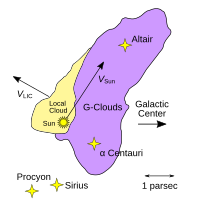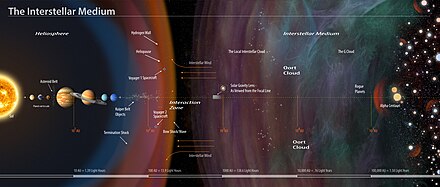| Interstellar cloud | |
|---|---|
 Diagram of surrounding stars and artist's conception of the Local Interstellar Cloud Diagram of surrounding stars and artist's conception of the Local Interstellar Cloud | |
| Observation data | |
| Constellation | None, Solar System is inside the nebula |
| Physical characteristics | |
| Dimensions | 30 ly (9.2 pc) |
| Designations | Local Cloud, LIC |
| See also: Lists of nebulae | |

The Local Interstellar Cloud (LIC), also known as the Local Fluff, is an interstellar cloud roughly 30 light-years (9.2 pc) across, through which the Solar System is moving. This feature overlaps with a region around the Sun referred to as the solar neighborhood. It is unknown whether the Sun is embedded in the Local Interstellar Cloud, or is in the region where the Local Interstellar Cloud is interacting with the neighboring G-Cloud. Like the G-Cloud and others, the LIC is part of the Very Local Interstellar Medium which begins where the heliosphere and interplanetary medium end, the furthest that probes have traveled.
Structure
The Solar System is located within a structure called the Local Bubble, a low-density region of the galactic interstellar medium. Within this region is the Local Interstellar Cloud (LIC), an area of slightly higher hydrogen density. It is estimated that the Solar System entered the LIC within the past 10,000 years. It is uncertain whether the Sun is still inside of the LIC or has already entered a transition zone between the LIC and the G cloud. A recent analysis estimates the Sun will completely exit the LIC in no more than 1,900 years.
The cloud has a temperature of about 7,000 K (7,000 °C; 12,000 °F), about the same temperature as the surface of the Sun. However, its specific heat capacity is very low because it is not very dense, with 0.3 atoms per cubic centimetre (5/cu in). This is less dense than the average for the interstellar medium in the Milky Way (0.5/cm or 8/cu in), though six times denser than the gas in the hot, low-density Local Bubble (0.05/cm or 0.8/cu in) which surrounds the local cloud. In comparison, Earth's atmosphere at the edge of space (i.e. 100 km above sea level) has around 1.2×10 molecules per cubic centimeter, dropping to around 50 million (5.0×10) at 450 km (280 mi).
The cloud is flowing outwards from the Scorpius–Centaurus association, a stellar association that is a star-forming region, roughly perpendicular to the Sun's own direction, if assumed to be two dimensional.
In 2019, researchers found interstellar iron-60 (Fe) in Antarctica, which they relate to the Local Interstellar Cloud.
Interaction with solar magnetic field

In 2009, Voyager 2 data suggested that the magnetic strength of the local interstellar medium was much stronger than expected (370 to 550 picoteslas (pT), against previous estimates of 180 to 250 pT). The fact that the Local Interstellar Cloud is strongly magnetized could explain its continued existence despite the pressures exerted upon it by the winds that blew out the Local Bubble.
The Local Interstellar Cloud's potential effects on Earth are greatly diminished by the solar wind and the Sun's magnetic field. This interaction with the heliosphere is under study by the Interstellar Boundary Explorer (IBEX), a NASA satellite mapping the boundary between the Solar System and interstellar space.
See also
- Gould Belt
- List of nearest stars and brown dwarfs
- List of nearby stellar associations and moving groups
- Orion Arm
- Perseus Arm
- Voyager program – probes left heliosphere in the 2010s
References
- "NAME LIC". SIMBAD. Centre de données astronomiques de Strasbourg. Retrieved March 15, 2014.
- Gargaud, Muriel; et al., eds. (2011). "Solar Neighborhood". Encyclopedia of Astrobiology. pp. 1526–1527. doi:10.1007/978-3-642-11274-4_1460. ISBN 978-3-642-11271-3. Retrieved 2022-07-01.
- ^ Gilster, Paul (September 1, 2010). "Into the Interstellar Void". Centauri Dreams.
- Linsky, Jeffrey (2020-03-23), "What lies immediately outside of the heliosphere in the very local interstellar medium (VLISM): morphology of the Local Interstellar Cloud, its hydrogen hole, Stromgren Shells, and 60Fe accretion", Egu General Assembly Conference Abstracts, Copernicus GmbH: 1410, Bibcode:2020EGUGA..22.1410L, doi:10.5194/egusphere-egu2020-1410, S2CID 226032795
- ^ "Our Local Galactic Neighborhood". Interstellar Probe Project. NASA. 2000. Archived from the original on 2013-11-21. Retrieved 2012-08-08.
- ^ Frisch PC, et al. (September 2011). "The Interstellar Medium Surrounding the Sun". Annual Review of Astronomy and Astrophysics. 49 (1): 252. Bibcode:2011ARA&A..49..237F. doi:10.1146/annurev-astro-081710-102613. Retrieved 2021-12-28.
- Linsky JL, et al. (November 18, 2019). "The Interface between the Outer Heliosphere and the Inner Local ISM". The Astrophysical Journal. 886 (1): 41. arXiv:1910.01243. Bibcode:2019ApJ...886...41L. doi:10.3847/1538-4357/ab498a. S2CID 203642080.
- Linsky JL, et al. (March 2020). "New results concerning the environment of the heliosphere, nearby interstellar clouds, and physical processes in the inter–cloud medium". Journal of Physics: Conference Series. 1620 (1): 012010. Bibcode:2020JPhCS1620a2010L. doi:10.1088/1742-6596/1620/1/012010. S2CID 225188522.
- ^ "Near-Earth Supernovas". NASA Science. NASA. January 6, 2003. Retrieved February 1, 2011.
- Boulanger, F.; et al. (2000). "Course 7: Dust in the Interstellar Medium". In Casoli, F.; Lequeux, J.; David, F. (eds.). Infrared Space Astronomy, Today and Tomorrow. Les Houches Physics School. Grenoble, France. August 3–28, 1998. Vol. 70. p. 251. Bibcode:2000isat.conf..251B.
- United States Committee on Extension to the Standard Atmosphere (October 1976). U.S. Standard Atmosphere, 1976. NOAA, NASA and U.S. Air Force. pp. 210–215. OCLC 3360756.
- Nemiroff, R.; Bonnell, J., eds. (February 10, 2002). "The Local Interstellar Cloud". Astronomy Picture of the Day. NASA. Retrieved December 21, 2016.
- Nemiroff, R.; Bonnell, J., eds. (February 17, 2002). "The Local Bubble and the Galactic Neighborhood". Astronomy Picture of the Day. NASA. Retrieved December 21, 2016.
- Koll, Dominik; et al. (August 2019). "Interstellar Fe in Antarctica". Physical Review Letters. 123 (7). 072701. Bibcode:2019PhRvL.123g2701K. doi:10.1103/PhysRevLett.123.072701. hdl:1885/298253. PMID 31491090. S2CID 201868513.
- Opher, M.; et al. (December 24–31, 2009). "A strong, highly-tilted interstellar magnetic field near the Solar System" (PDF). Nature. 462 (7276): 1036–1038. Bibcode:2009Natur.462.1036O. doi:10.1038/nature08567. PMID 20033043. S2CID 205218936.
Further reading
- "A Breeze from the Stars" at NASA Science
- "Voyager Makes an Interstellar Discovery" at NASA Science
- "Local Chimney and Superbubbles"
- Anderson, Mark (January 6, 2007). "Don't stop till you get to the Fluff". New Scientist. 193 (2585): 26–30. doi:10.1016/S0262-4079(07)60043-8.
External links
 Media related to Local Interstellar Cloud at Wikimedia Commons
Media related to Local Interstellar Cloud at Wikimedia Commons
| Location of Earth | |
|---|---|
| Included | Earth → Solar System → Local Interstellar Cloud → Local Bubble → Gould Belt → Orion Arm → Milky Way → Milky Way subgroup → Local Group → Local Sheet → Virgo Supercluster → Laniakea Supercluster → Local Hole → Observable universe → Universe Each arrow (→) may be read as "within" or "part of". |
| Related | |
